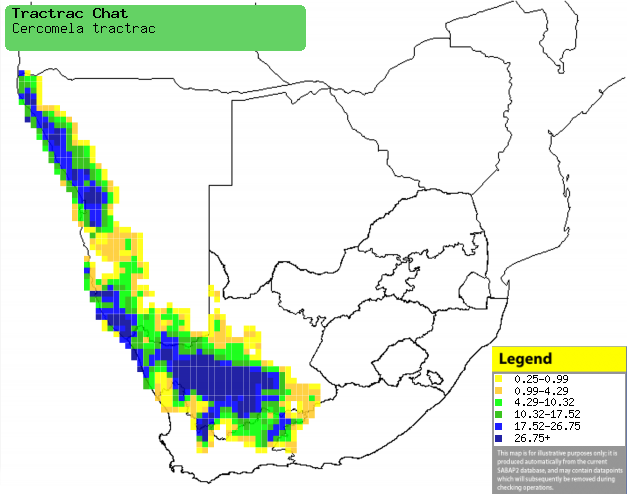|
Cercomela tractrac (Tractrac chat)
Woestynspekvreter [Afrikaans]; Woestijn-spekvreter [Dutch]; Traquet
tractrac [French]; Namibschmätzer [German]; Chasco-pálido [Portuguese]
Life
> Eukaryotes >
Opisthokonta
> Metazoa (animals) >
Bilateria >
Deuterostomia > Chordata >
Craniata > Vertebrata (vertebrates) > Gnathostomata (jawed
vertebrates) > Teleostomi (teleost fish) > Osteichthyes (bony fish) > Class:
Sarcopterygii (lobe-finned
fish) > Stegocephalia (terrestrial
vertebrates) > Tetrapoda
(four-legged vertebrates) > Reptiliomorpha > Amniota >
Reptilia (reptiles) >
Romeriida > Diapsida > Archosauromorpha > Archosauria >
Dinosauria
(dinosaurs) > Saurischia > Theropoda (bipedal predatory dinosaurs) >
Coelurosauria > Maniraptora > Aves
(birds) >
Order: Passeriformes > Family: Muscicapidae
> Genus: Cercomela
Distribution and habitat
Near-endemic to southern Africa, occurring from
south-western Angola through western Namibia to the Northern Cape, marginally
extending into the Western and Eastern Cape. It generally prefers open plains
with scattered shrubs, perennial grassland, Karoo and dune shrubland
|
 |
|
Distribution of Tractrac chat in southern Africa,
based on statistical smoothing of the records from first SA Bird Atlas
Project (©
Animal Demography unit, University of
Cape Town; smoothing by Birgit Erni and Francesca Little). Colours range
from dark blue (most common) through to yellow (least common).
See here for the latest distribution
from the SABAP2. |
Food
It mainly eats insects, doing most of its foraging on the
ground sometimes on gravel roads, as it likes to feed on road-killed beetles. The following food items have been recorded
in its diet:
Breeding
- The nest is a deep cup, set into a foundation of dry twigs and sticks and
lined with fluffy seeds of plants such as the Karoo rosemary (Eriocephalus).
It is typically placed beneath a shrub, next to a stone or inside a
Welwitschia mirabilis plant, often facing east or south-east to maximise
shade during the heat of the day.
- Egg-laying season is from about August-April, peaking from
September-October.
- It lays 2-3 eggs, which are incubated by both sexes.
- The chicks leave the nest after about 18 days, remaining under their
parents care for at least 9 weeks (in one observation).
Threats
Not threatened, although overgrazing of Karoo shrubland is
cause for concern.
References
-
Hockey PAR, Dean WRJ and Ryan PG 2005. Roberts
- Birds of southern Africa, VIIth ed. The Trustees of the John Voelcker
Bird Book Fund, Cape Town.
|
